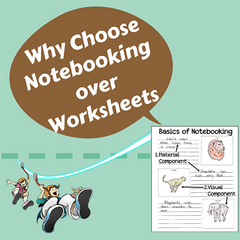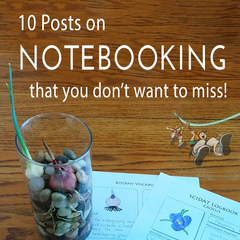FREE Shipping on all our products! (Please expect 1 to 1.5 weeks for delivery due to transit delays. We ship every day including Saturday
FREE Shipping on all our products! (Please expect 1 to 1.5 weeks for delivery due to transit delays. We ship every day including Saturday
What should elementary science look like in our homeschool?
May 18, 2020 5 min read

So you have made the decision to homeschool your precious little one, but you have one lingering doubt about your choice - a fear that you won't be able to teach science.
Sure, you made it through those pesky science classes, but you didn't really enjoy them. Or you don't remember a bit of the science you did learn.
But you know that research says that the earlier you introduce science, the more likely it is that your student will succeed. And as a homeschooler, you want to change the educational narrative from your past. You want to give your student a new story about education and set them up for a lifelong pursuit of learning.
So how do you do this for science?
Well, the good news is that elementary science is simply about nurturing an interest or about sparking a desire to learn more. You can relax about standards and key facts. Trust me if you introduce the basics through the three keys for teaching science, you will cover everything that you need to cover.
And the even better news is that you can mold these three keys into a tapestry that fits your unique homeschooling style.
Sound good?
Let's dig in...
(This post is part of our "how-to teach science" series<-click the link to see the rest of the tips.)
What should elementary science look like in your homeschool?
The video below is a grab-a-cup-of-coffee-and-get-comfortable-because-the-rubber-is-meeting-the-road conference session where I explain what you need to know about elementary science and the options you have for your homeschool.
If you don't have the 34 minutes and 51 seconds to watch it now, you can skip over the video and read the summary below.
Your Goals for Elementary Science

Your elementary students have a natural curiosity that is combined with a high capacity for retaining information. So, your goals for teaching science to them will play to these strengths while filling their bucket with scientific information.
You have the two goals when it comes to teaching science during the elementary years:
- First, you want to create an interest in the student for learning science.
- Second, you want to fill the student’s mind with interesting, but basic scientific information.
In short, these are learning the fundamentals of the three R’s, but this doesn't mean you should neglect the basics of science. During these years, you can create interest, nurture that spark, and fill their bucket with the simple, yet interesting facts of science.
Your Tools for Elementary Science
Now that you have your goals in mind, let’s look at the basic tools you need to craft a plan for science during the elementary years. You will need three basic components:
- Hands-on Science – You can use scientific demonstrations or nature studies or make models of scientific concepts. The point is that you want your students to work on their observation skills and see (or experience) science face-to-face.
- Information – You can use either living books, textbooks, or encyclopedias to feed your student with information. You can also use vocabulary to reinforce what the students are learning.
- Writing – Oral dictation, lapbooks, notebooks, and/or comprehension worksheets can all be used for elementary science writing. Basically, you want to use writing to help the students learn to share the information they have learned.
You can also add in a few extras to your science plans – these are purely optional! But to develop more interest, you can add in things like STEAM projects and memory work to your weekly plans.
How elementary science can look in your homeschool...
How you put it all together will vary from homeschool to homeschool. Basically you need to have some kind of hands-on science, information, and writing each week. If time and interest allow, you can sprinkle in a few extras along the way.
- Some homeschoolers might start by reading from a living book. Then, they will head outside to find the principles brought up in the book in nature. They will finish the week by writing a short narration on what they learned about the topic.
- Others will start the week with a scientific demonstration. Then, they will read about the principles involved in an encyclopedia. They will finish up their week by adding a mini-book on the subject to their lapbook.
- Others might start the week by reading in a textbook and filling out a comprehension worksheet from the chapter. Then, they will finish by doing a related hands-on activity in which they see the principles from the text in action.
All these methods are acceptable ways to study science with your elementary school student. And so or the other combinations you can dream up!
Elementary Science In a Nutshell
I trust that I have given you a better idea of what elementary science can look like in your homeschool. These years are perfect for nurturing a passion or sparking an interest in learning science that will serve you well in later years.
If you want to listen to a more in-depth look at elementary science, check out the following podcast series:
- Episode 64 – The Elementary Years Part 1: Goals
- Episode 65 – The Elementary Years Part 2: Tools
- Episode 66 – The Elementary Years Part 3: Methods
And to see a big picture look at how your plans for science will change through the years, check out Simple Homeschool Science - A Roadmap to Teaching Science at Home.
And that's a wrap! If you have more questions about elementary science, please feel free to leave them in the comments below.
Psst...Need help with elementary science?
Okay, I did have one more thing to say. If you need help, we have got you covered with several options of complete plans for elementary science. Here are the options:
- From the Classical Science Series - Our award-winning Classical Science Series explores an area of science over a full school year. These programs use additional children's encyclopedias and experiment books. In addition to the teacher guide, which contains a buffet of options for each week, we offer student notebooks, lapbooking templates, and coloring pages. We also have put together experiment kits to make finding the materials for the demonstrations in the program a cinch. You can check out Biology for the Grammar Stage, Earth Science & Astronomy for the Grammar Stage, Chemistry for the Grammar Stage, and Physics for the Grammar Stage.
- From the Sassafras Science Series - Our Sassafras Science series takes your students on a journey to learn about science! This series is based on our wildly-popular, modern living books for science, The Sassafras Science Adventures. In addition to the adventure-packed novel, we offer several support materials to enhance your journey - an activity guide, SCIDAT logbooks, a lapbooking guide, and coloring pages. We also have put together experiment kits to make finding the materials for the demonstrations in the program super easy! The currently available novels include Volume 1: Zoology, Volume 2: Anatomy, Volume 3: Botany, Volume 4: Earth Science, Volume 5: Geology, and Volume 6: Astronomy.
You can also check out our science lapbook options for elementary science.
Also in Elemental Science Blog
What is the difference between a report and a research paper for science?
May 13, 2024 2 min read

In the middle school and high school years, students frequently receive assignments for research papers or reports in science and history. But what is the difference? And how to you go about writing both of these? Click "Read More" to get answers.
Why Choose Notebooking over Worksheets? Here are 3 Reasons...
May 06, 2024 2 min read

Why choose notebooking over worksheets? Click "Read More" to see three reasons why we have chosen notebooking over worksheets.
10 Posts On Notebooking That You Don’t Want To Miss
April 22, 2024 3 min read

We love notebooking at Sassafras Science! And these ten posts on notebooking will help you understand the how's and why's of this super effective tool.
Subscribe
Sign up to get the latest on sales, new releases and more …

